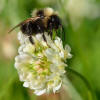WILD
FOODIES' HOME PAGE
PLANT PROFILE LIST
NAME: White Clover
SPECIES / FAMILY: Trifolium Repens / Fabaceae or Leguminosae (legume)
COMMON NAME(S): Dutch clover, Ladino clover, or Ladino
CONDITIONS: sun
|
PARTS: |
EDIBLE |
TASTE |
RAW/COOK |
SEASON |
|
All |
|
|
|
Spring-Fall |
|
Shoots |
|
|
|
|
|
Leaves |
|
RAW/COOK |
Spring-Fall |
|
|
Buds/Flowers |
|
RAW/COOK |
Spring-Fall |
|
|
Fruits |
|
|
|
|
|
Roots |
|
COOK |
||
|
Seeds |
|
|||
|
Nuts |
|
|
|
|
|
Pods |
|
|
|
|
|
Stalk |
|
|
|
|
|
Bark |
|
|
|
|
PORTION: small
COMMENT: Taste of flowers depends on if bees already ate the nectar. Flowers can be dried and ground into flour. Root can be dried before cooking.// Leaves - raw or cooked as a potherb. The young leaves are harvested before the plant comes into flower and are used in salads, soups etc. They can also be used as a vegetable, cooked like spinach. The leaves are best cooked. Flowers and seed pods are dried, ground into powder and used as a flour or sprinkled on cooked foods such as boiled rice. Very wholesome and nutritious. The young flowers can also be used in salads. Root - cooked. The dried leaves impart a vanilla flavour to cakes etc. Dried flowering heads are a tea substitute.(1) One of the more surprising sides of clover is that it’s in the pea family, and its blossom is actually a bunch of little pea-like blossoms, called ”wings and keels.” Clover is also a native of Europe and western Asia but has been used as a pasture crop worldwide. And while there are few pasture in the Arctic, clover grows from the top of the earth to the bottom and all around, nearly every location on the rotation. Though well-known as totally edible, from blossom to root, it is not choice “eating wild.” (2)
CAUTION: The flowers and leaves must be used either within 30 minutes after picking or left to dry for 4-6 weeks. Soon after being picked the plant starts producing cyanide compounds and in an hour or less they can become dangerous to eat. If left to dry for 4-6 weeks these cyanides will disappear. For this reason one should NOT include clover when making sauerkraut, kimchi, or other fermented greens as the fermentation process doesn't interfere with the production of cyanide.(4) Clover does come with three words of warning, however: One is that quite a few people are allergic to it and don’t know it, so go easy at first until you know one way or the other. Secondly, NEVER …. did you see that word? NEVER ferment and eat any part of it. You want your clover either completely fresh or completely dried, Never in between. Lastly clover in warm climates can produce small amounts of cyanide. (2)
NUTRITION/MEDICINAL: Vitamin A & C, calcium, iron, sterols, and flavonoids.(4) Antirheumatic; Antiscrophulatic; Depurative; Detergent; Ophthalmic; Tonic. (1)
LOOK-A-LIKES: other clovers, wood sorrel http://www.foragingtexas.com/2008/08/wood-sorel.html
POISONOUS LOOK-A-LIKES:
OTHER USES: green manure (1)
SOURCE LINKS (may include nutritional and medicinal info, plus other uses):
- https://pfaf.org/user/plant.aspx?LatinName=Trifolium+repens
- http://www.eattheweeds.com/clover-available-around-the-world-2
- https://en.wikipedia.org/wiki/Trifolium_repens
- http://www.foragingtexas.com/2008/08/clover.html (good photos)
- https://commons.wikimedia.org/wiki/Trifolium_repens (good photos)
- https://thewoksoflife.com/edible-clover-cao-tou
- https://www.tasteofhome.com/recipes/clover-honey
- https://practicalselfreliance.com/clover-blossom-flour
- https://www.phillyorchards.org/2019/08/05/eat-your-yard-clover-and-friends
- https://www.thehealthjournals.com/clovers-are-edible
- https://www.survival-manual.com/edible-plants/clover.php
- 4-leaf clover - https://en.wikipedia.org/wiki/Four-leaf_clover


